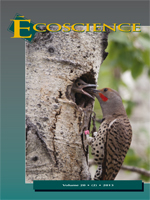Montane riparian forests exhibit a higher diversity of tree species than adjacent stands. This pattern is thought to be generated by the unique disturbance regime of riparian forests, including canopy gap formation and fluvial disturbance (e.g., transport of boulder/gravel sediments), which provides a variety of habitat conditions for regeneration (habitat niche segregation). Although segregation of micro-environmental conditions for seedling establishment has been confirmed, habitat segregation for saplings remains untested. Thus, to determine if the composition and structure of the riparian sapling community is influenced by canopy and fluvial disturbances, we sampled 11 canopy-gap sites and 3 fluvial boulder-deposit sites, as well as beneath-canopy sites that had not been disturbed recently, in a temperate mixed-species deciduous forest. We analyzed the distribution patterns of saplings for 31 canopy and subcanopy species. Saplings were found mainly on the disturbed sites compared with the beneath-canopy sites. A comparison of relative densities for 13 major species in gaps versus on fluvial deposits revealed that 5 species were biased significantly to gaps and 4 species to fluvial deposits. Cluster analysis detected 4 species groups with different light requirements. These results suggest riparian habitat partitioning between species through differentiated preferences for the disturbance type × light requirement combination.
How to translate text using browser tools
1 June 2013
Interactive Effect of Canopy and Fluvial Disturbances on Sapling Community Structure and Species Diversity in a Montane Riparian Forest1
Shinji Oki,
Tatsuro Akiyoshi,
Daisuke Hoshino,
Mitsue Shibata,
Michinari Matsushita,
Kazuhiko Hoshizaki
ACCESS THE FULL ARTICLE

Ecoscience
Vol. 20 • No. 2
June 2013
Vol. 20 • No. 2
June 2013
banque de gaules
Canopy gap
fluvial sediment transport
habitat partitioning
multiple disturbance regimes
niche de régénération
regeneration niche




